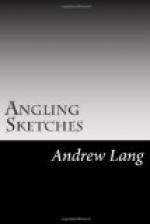Loch Awe would have contented me less had I been less fortunate in my boatman. It is often said that tradition has died out in the Highlands; it is living yet.
After three days of north wind and failure, it occurred to me that my boatman might know the local folklore—the fairy tales and traditions. As a rule, tradition is a purely professional part of a guide’s stock-in-trade, but the angler who had my barque in his charge proved to be a fresh fountain of legend. His own county is not Argyleshire, but Inverness, and we did not deal much in local myth. True, he told me why Loch Awe ceased—like the site of Sodom and Gomorrah—to be a cultivated valley and became a lake, where the trout are small and, externally, green.
“Loch Awe was once a fertile valley, and it belonged to an old dame. She was called Dame Cruachan, the same as the hill, and she lived high up on the hillside. Now there was a well on the hillside, and she was always to cover up the well with a big stone before the sun set. But one day she had been working in the valley and she was weary, and she sat down by the path on her way home and fell asleep. And the sun had gone down before she reached the well, and in the night the water broke out and filled all the plain, and what was land is now water.” This, then, was the origin of Loch Awe. It is a little like the Australian account of the Deluge. That calamity was produced by a man’s showing a woman the mystic turndun, a native sacred toy. Instantly water broke out of the earth and drowned everybody.




